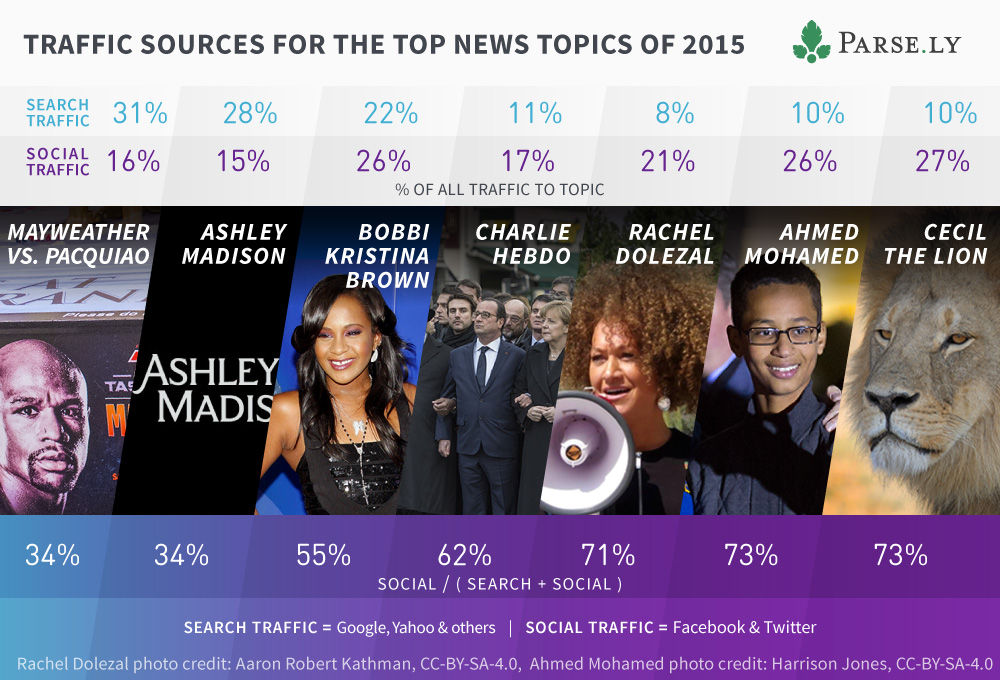Social Media Drives Referrals to Digital Publishers in 2015
How did readers discover the top news of 2015?
For the biggest news stories this year, social media traffic dominated search referrals within the Parse.ly network of more than 400 media sites.
The Parse.ly team identified the top seven news events based on the most-read stories in our network. We only considered stories that had one “event” at their core (sorry Donald Trump and the Kardashian clan!), then we normalized the data based on site size because we didn’t want our biggest sites to dictate the trends. Once we compiled this list of top stories, we looked at how readers landed on each story to see what patterns we could find.
Since the digital publishing industry has been so focused on the growth of social as a medium for news distribution at the expense of search, we wanted to see if this held true for individual stories. So for each of our top news events, the Parse.ly team checked on the referral traffic from social sources and search sources. You’ll find the results below.

For a complete overview of Parse.ly’s findings, please download the full Authority Report here.
You can read the whole report for more analysis, but below are four interesting takeaways from the data.
Bobbi Kristina Brown: Shares (Not Search or Social Referrals) are a New Form of Sympathy

Perhaps one of the reasons that Bobbi Kristina Brown’s story garnered so much attention from the media was that it was ever-changing. The story was continuously updated — from the moment that Ms. Brown was taken from her home in an ambulance, to confirmation that she was in a coma, to when she awoke from the coma, to the time of her death — and readers relied on social media to communicate these updates from publisher websites.
There was a spike in pageviews around Ms. Brown’s death, but it was relatively small. However, in looking at data from BuzzSumo, a content discovery tool, the Parse.ly team noted a huge spike in shares around the topic — two times more shares than when Ms. Brown fell into a coma — despite no noticeable increase in the amount of articles being written.
One hypothesis for the increase in article shares, despite very few additional articles being published, is that readers were only reposting articles in sympathy of Ms. Brown’s death. The articles went largely unread because would-be readers already knew what had transpired.
Cecil the Lion: Viral Story Updates Do Not Pay Off (in Pageviews) for Digital Publishers

The “Cecil the Lion” story had no connection to any larger national trends or breaking news stories; it was a smaller story that became national news because it elicited an emotional reaction and caused outrage — two reasons why some stories go “viral.”
From the data that Parse.ly collected, it seems that viral pieces really are one-hit wonders: the follow-up wave of media coverage around Cecil the Lion did not manage to bring in readers at the scale of the initial wave of coverage.
The Ashley Madison Hack: Psychology Helps to Shape Referral Traffic Patterns

When hackers hit the Ashley Madison site, the topic attracted a significant fraction of social referrers (34.1 percent); however, the majority of traffic (65.9 percent) came from search engines.
Our hypothesis is that the elicit, and possibly amoral, subject matter was something that people wanted to read about, yet didn’t want to show their social networks publicly. If this is the case, it’s a good example of how psychology plays a role in shaping media traffic.
Ahmed Mohamed: Social Outrage Triggers Social Referrals to Digital Publishers

Ahmed Mohamed’s story had the shortest lifespan of any of the news topics we looked at in 2015. The local news story caused social outrage, triggering national attention; it quickly went “viral,” but because there was virtually no organic traffic coming from search engines, it died out quickly.
This is likely because, after the initial story, there was limited additional information to report. Instead, readers were compelled to share articles in the context of their own opinions about the events that transpired — and this took place via Facebook and Twitter, primarily.
What Do We Expect to See in 2016?
Both social and search traffic drive referrals to publisher websites at different scales, and in response to different types of news stories. And although no two stories — and no two news topics — are exactly alike, digital publishers can look at some of the patterns that emerged from 2015 to help understand how their news will be distributed via search and social in 2016 and beyond.
Based on the data we gathered from our most recent Authority Report, it is clear that social media is pushing breaking news. Topics that bubble up (versus top-down, often publisher-driven stories) will be driven by social “conversations” in 2016. If they are not doing so already, sites who provide their audience with breaking news should be investing heavily in social.
Search traffic is bringing fewer readers to digital publishers; yet, it remains one of the top referrers to evergreen articles. Publishers who invest time and effort in long-form journalism can remain relevant by finding out who is reading their evergreen content and keeping tabs on existing audience’s preferences and past reading trends.
Interested in learning more? Download Parse.ly’s newest Authority Report (“Understanding Traffic Patterns from the Top News Topics of 2015”) here.